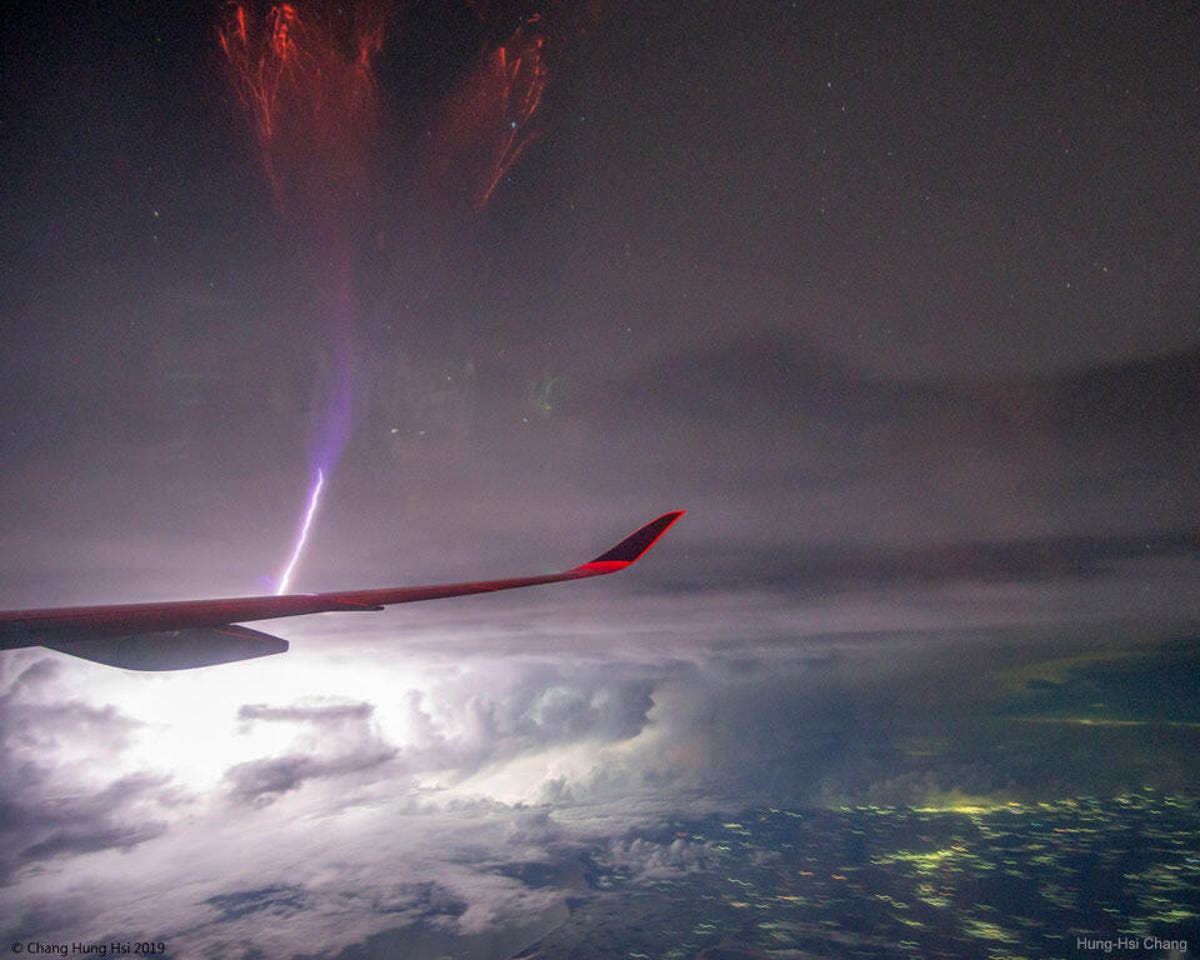On May 14, 2018, a tempest straight from The Twilight Zone rained over Oklahoma.
Rather than scatter the Earth with jagged lightning bolts, the shrouds of dense clouds powering this storm spit one 50 miles upward, far enough to graze the ionosphere, or the edge of space. This violent, backward burst of electricity would soon be classified as one of nature's most mysterious atmospheric phenomena: A gigantic jet.
Gigantic jets are simply luminous beams born alongside regular lightning bolts, yet pointed in the opposite direction. But they're a lot stronger than their downward-facing counterparts, sometimes even threatening space vehicles or other technologies floating in our planet's orbit. And this particular one was incredibly intense. It's considered the most powerful of its kind studied so far, carrying an estimated 300 coulombs of electrical charge, a whopping 100 times more than typical lightning bolts hold.
Over the past two decades, scientists have identified several of these strange forces, but many of those sightings were accidental catches from the public.
For instance, a violet streak was imaged from an airplane passing over Bhadrak, India and another was spotted with a nighttime camera near the 6,240-foot summit of Shikengkong mountain in China. In 2013, NASA added an experiment to the ISS in order to help get a better, more actively placed look at the scene above cloud tops so we can catch gigantic jets in action. Still, the science community doesn't have many observing systems tailored to the search.
Which is why Oklahoma's 2018 incident was serendipitous.
By happenstance, this extreme event occurred close to a bunch of relevant science instruments in the state, like satellite networks and a lightning-mapping system that detects what are called "very high frequency signals." A citizen-scientist in the area even photographed it with a low-light camera. So, drawing on all of these clues, a crew of scientists collected as much data as possible about the jet to try to paint a detailed retelling of what happened four years ago in the swirling Oklahoman sky.

This gigantic jet was captured on a single 3.2-second exposure above Bhadrak, India. Although the gigantic jet appears connected to the airplane's wing, it likely started in a more distant thundercloud and can be seen extending upwards towards Earth's ionosphere.
Hung-Hsi Chang/NASA"We were able to map this gigantic jet in three dimensions with really high-quality data," Levi Boggs, a research scientist at the Georgia Tech Research Institute and an author of a paper on the structure published Aug. 3 in the journal Science Advances, said in a press release.
Such a three-dimensional structure is important in the quest to decode gigantic jets because their ascension from clouds means they're often obscured from view. "We were able to see very high frequency sources above the cloud top, which had not been seen before with this level of detail," Boggs said. And those VHF signals offered a goldmine of information about gigantic jets.
Basically, lightning bolts emanating from thunderstorm clouds are produced by a combination of leaders and streamers. Leaders are the result of electrical charge differences that help develop lightning, and streamers are found at the very tip of those developing bolts. Together, these forces work to propagate electricity channeled from within the stormy cloud, but leaders typically form the bulk of discharge.
The new study's researchers first of all definitively saw the gigantic jet-producing leaders and streamers were situated above the thunderstorm cloud during Oklahoma's event, rather than toward the bottom where they'd normally be found. Second of all, "the radio and optical data show the first clear evidence that the VHF observed by lightning networks is produced by streamers ahead of the leader," the study authors wrote.
"Those cold streamers start their propagation right above the cloud top," Boggs explained. "They propagate all the way to the lower ionosphere to an altitude of 50-60 miles, making a direct electrical connection between the cloud top and the lower ionosphere."
Beyond that, the team dissected many other interesting gigantic jet charge dynamics and even settled on one possible explanation for why these odd beams spurt out at all. "For whatever reason, there is usually a suppression of cloud-to-ground discharges," Boggs said of records collected from the Oklahoma event. "In the absence of the lightning discharges we normally see, the gigantic jet may relieve the buildup of excess negative charge in the cloud."
In other words, some thunderstorm clouds might be bottling up their negative energy -- and as they say, that's bound to come out one way or another.
Article From & Read More ( Scientists Investigate Upside-Down Lightning Bolt That Touched the Edge of Space - CNET )https://ift.tt/iIpxZh1
Science
No comments:
Post a Comment